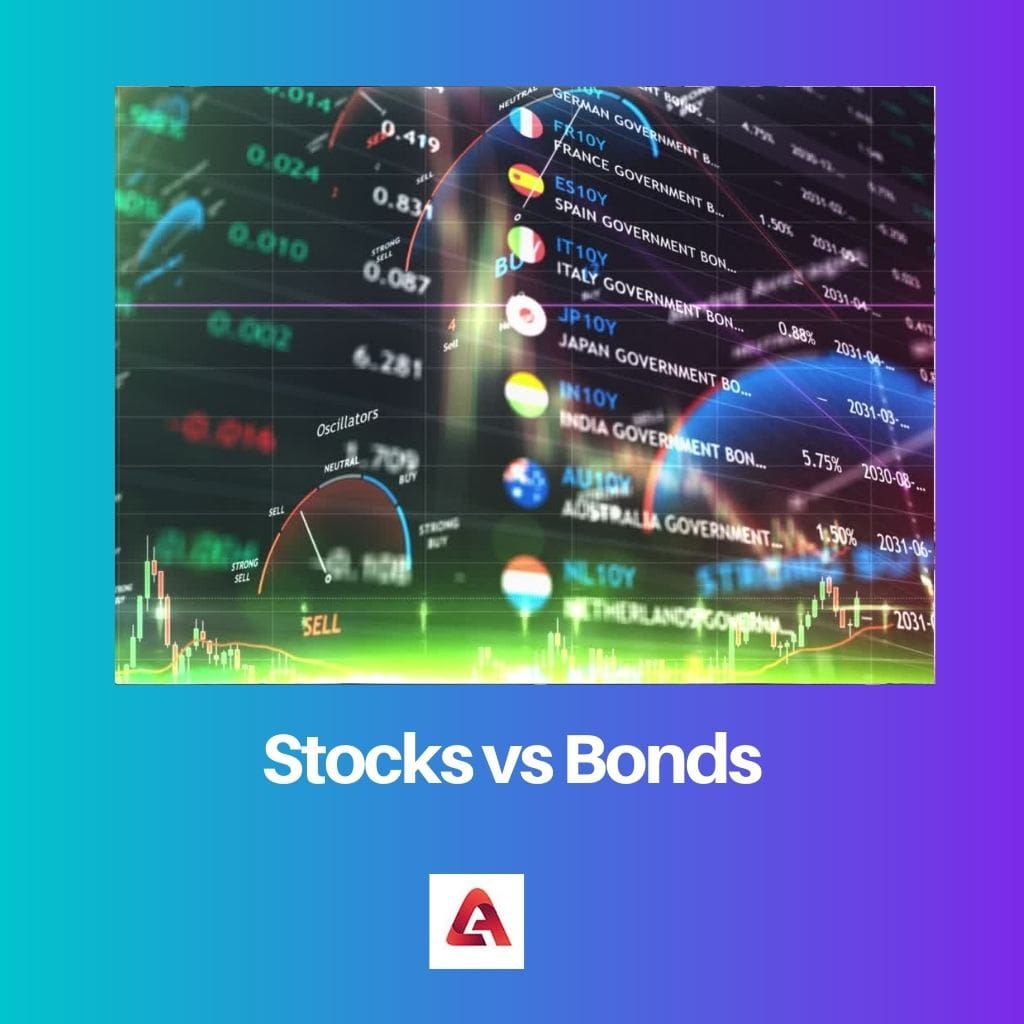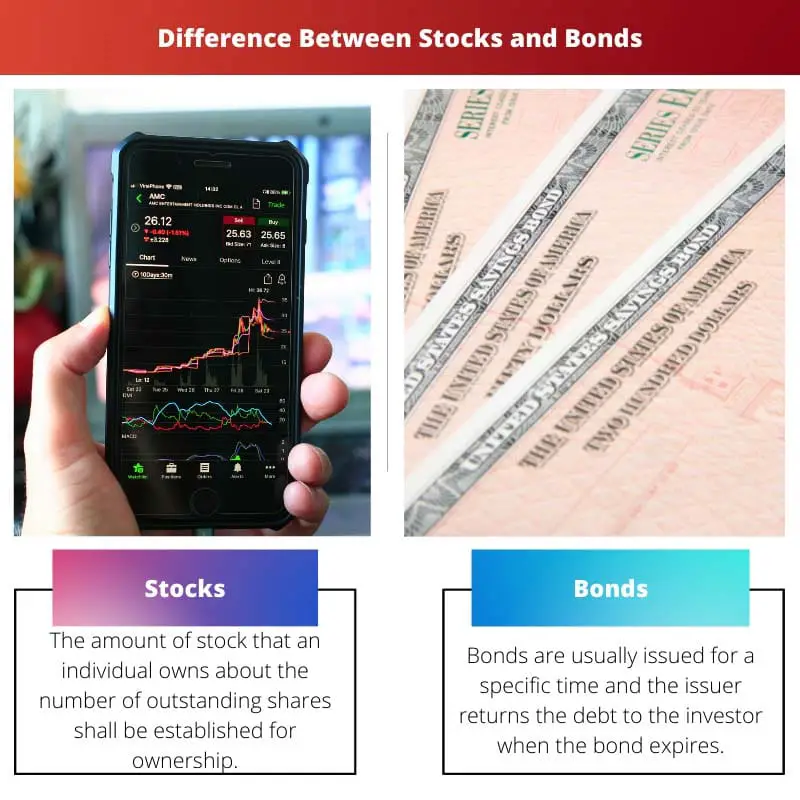The two fundamental types of assets used in the portfolios are stocks and bonds. Stocks represent an equity interest in a business, while bonds are equivalent to debt to a business or other entity.
When an individual purchases stock from a company, it means the individual partly becomes the owner of the company, and in the case of bonds, no ownership is created.
A bond is a fixed-income asset in which a lender owes money to an organization that collects the funds for a specific amount of time at a variable or fixed interest rate. Businesses use bonds, corporations, nations, and governments to collect capital to fund a wide range of programs and activities.
The holders of the bond become the debt holders or bondholders of the lender.
Key Takeaways
- Stocks represent partial ownership or equity in a company, allowing investors to participate in its growth and receive dividends based on its performance.
- Bonds are debt instruments issued by companies, governments, or other entities. The issuer promises to pay the bondholder a fixed interest rate and return the principal at maturity.
- The key difference between stocks and bonds is that stocks offer ownership and potential capital gains, while bonds provide fixed income and are considered a more conservative investment.
Stocks vs Bonds
Stocks give you a stake in an organization. They need to increase in value and be sold on the stock market later to generate profit. Stocks have a chance to generate larger long-term gains. While bonds are loans you make to businesses or the government. Most bonds have an ongoing set interest rate.

Comparison Table
| Parameter of Comparison | Stocks | Bonds |
|---|---|---|
| Meaning | A part of ownership in the company which entitles a right in profit only for the part owned by purchasing shares of the company is known to be stock. | Loan granted by any individual to an organization, company, entity, etc., for a specified period at a fixed rate of return |
| Type of Right | Securities | Debt |
| Key Person -Owner | Stock Holder/Share Holder | Bond Holder |
| Returns | Profits | Interest |
| Voting Rights | Yes | No |
What are Stocks?
Businesses sell stocks to raise funds to run their companies. A stockholder has now purchased one portion of the company and can claim a portion of its assets and profits based on the type of stock kept.
In other words, the owner of the issuing company is now the shareholder. The amount of stock that an individual owns about the number of outstanding shares shall be established for ownership.
For instance, if you are buying stock from a company for $1 and the company’s total value is $100, you are said to be the owner of the company for 1% of its total value and entitled to profits for the 1% of shares held.
After the purchase of stocks, if the price of the stock goes as a result of an increase in the company’s value, the purchaser can sell it and earn profits out of it.
Unless sold, the person can receive revenue on the number of shares held in respect of the company’s profits at a fixed interval (i.e. quarterly, half-yearly, annually) in the form of a dividend.
Usually, there are two types of stock, viz. Common Stock and Preferred Stock. The central portion of the stocks in the market was issued in Common Stocks.
The common stock yields higher returns than just about any other income through capital growth. This greater yield is affordable because common stocks involve the most risk.
Preferred stock does not have the same voting rights as ordinary shares.
One bonus of preferred stocks is that preferred stocks are paid first to common stock in the case of liquidation and that it is, therefore, more debt than equity.

What are Bonds?
This is perhaps the most popular form of security and a debt mechanism that periodically makes fixed-interest payments and charges the principal sum to maturity rates.
Bonds issued by companies, governments, joint ventures, etc., to fund different ventures. Bonds are issued for a specific time, and the issuer returns the debt to the investor when the bond expires.
When the first bond is issued, its value is the sum borrowed, called the face value, and the investor receives a guaranteed income called a coupon in return.
Risk in a bond is based on the issuer’s creditworthiness and not on market fluctuations. Investor bonds are available in several different categories.
Two notable categories are discussed below.
Zero-Coupon Bonds are reduced in the price of their nominal value to generate a return until the total face value of the bond is paid at the maturity of the bond.
A convertible bond is a form of fixed-income debt that offers interest paid but can be transformed into a specified number of Equity shares. At certain stages of the life of the bond, the holder can convert bonds to stocks.
While buying a bond, a person should look into a few essential factors, viz. Duration, amount of expense it requires, issuer creditworthiness, rate of return, and previous records of the issuer about bonds.
The downside of stocks versus bonds is that stocks are not guaranteed to give the investor anything, and bonds produce relatively reliable returns through coupon payments. Stocks have a more significant potential for high returns; nevertheless, capital may be lost.

Main Differences Between Stocks and Bonds
- A company, entity, organization, etc., can raise money for function in two main ways (i.e., selling or borrowing). Stocks are selling off shares of the company while borrowing debts from various investors by issuing bonds.
- Risk: In the case of Stock, the risk is comparatively higher than bonds as earnings in stock are mainly based on the liquidity of the company, but in bonds, the risk is high to the issuer of the bond
- Stockholders have the right to vote in the cases of electing directors and managerial decisions related to the company, whereas bondholders are debtors who don’t have voting rights.
- The returns in Stock are dividend which is paid at a fixed interval time based on the company’s earnings and the number of stocks owned by the holder. The returns on the bond interest are fixed as the interest rate rarely changes, and on the maturity of the bonds, the issuer of the bond has to repay the principal.
- When liquidation occurs, the priority of stocks is at the bottom of the scale, whereas bonds are paid before stocks.


The article strikes a balance between informative content and readability, making it a valuable resource for those looking to understand stocks and bonds.
The detailed explanation of stocks and bonds in this article makes it easier for readers to understand complex financial concepts.
The distinction between stocks and bonds has been made clear in this article, benefiting both novice and seasoned investors.
I am impressed with the thoroughness of this article in explaining the concepts of stocks and bonds. The comparison table is especially useful.
The detailed comparison of stocks and bonds here is quite informative and valuable for those interested in investment.
The article effectively outlines the differences between stocks and bonds, aiding in financial literacy among readers.
The breakdown of stocks and bonds here perfectly explains their functions without any room for misinterpretation.
This article provides a detailed explanation of the difference between stocks and bonds, as well as their characteristics and how they are used in portfolios.
This article provides a great resource for individuals looking to learn more about the differences between stocks and bonds.
The breakdown of stocks and bonds provided here is an excellent resource for those looking to expand their knowledge in finance.